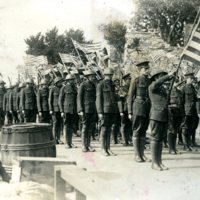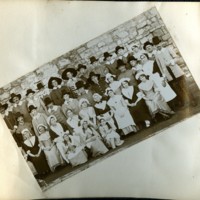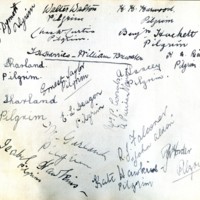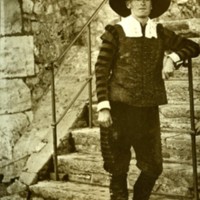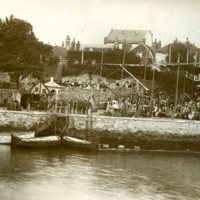Description
Written by Canon Leville Lovett and his daughter Myra, ‘John Alden’s Choice’ was the crowning glory of Southampton’s 1920 celebrations for the 300th anniversary of the sailing of the Mayflower. Staged four times by a large cast of 444 amateur performers, it took place right on the West Quay in front of the 1913 Pilgrim Father’s Memorial, and up to 700 people at a time could see a performance. In many ways the pageant diverged from the local chronological approach that most historical re-enactments in Britain took at this time. A lot of the action was set in the United States, part of the story was a vision of the future from a contemporary character, and the production mixed comical farce with serious topics like slavery, racism and war.
The pageant began with a prologue that exhorted the audience to imagine the Mayflower on its way out to sea, since it carried ‘Alden, of our Town’ – a man who saw ‘within a vision clear… what should be’. The first Act went back to the town quay in 1620, and depicted the bustling docks. Plenty of drama and humour were apparent – from a fleeing French Huguenot being found in a barrel to John Alden himself being put in the stocks by the town beadle. The Pilgrims, preparing to leave the port, came across Alden and – thinking he had been imprisoned because of religious intolerance – invite him to join them for ‘the freedom of the Americas’. To help Alden make his ‘choice’, a mysterious gypsy appeared and showed him visions from the American future: in 1621, John Carver meeting the ‘Red Indians’ and informing them that William Bradford will be their ‘chief’, before Massasoit, the Wampanoag leader, declared peace between the two peoples; in 1773, the Boston Tea Party and the beginnings of the breaking away of New England from Britain; in 1789, George Washington giving a speech during the American Revolutionary War; and, in 1863, Abraham Lincoln giving the Gettysburg Address against the backdrop of arguments about the morality of slavery (with local people playing slaves in blackface).
Finally, the gypsy showed Alden an allegorical vision of the First World War, with the ‘Spirit of America’ declaring:
'Far across the sea I heard faint voices calling, and they waked old longings, old forgotten memories, old ties of blood, and friendships of the past, and I remembered I was born of England, born of the men who sailed from this far port… all the long past, and love, and the close tie which bound us once together, turned me and came again whence sailed the Mayflower.'
The ‘Spirit of Britannia’ welcomed America, and declared ‘daughter, in losing I gain a mighty friend, we now together will drive and bind and break a bitter foe.’ Auld Lang Syne was then sung as soldiers, British and American, crossed the stage.
After each of these visions, Alden – back in 1620 – was asked whether he would leave his home country for the New World. It was only when he saw that the journey of the Pilgrim Fathers would lead to Allied victory in 1918 that he finally decided to leave Southampton.
Many Americans – like J. Butler Wright, the Counsellor of the American Embassy and General C.H. Sherill - came to watch the opening performance, and the town and port were bedecked with American flags. Local press declared it ‘good pageantry’ for its idealism and inspiration, and, overall, ‘a great success.’ In dramatic form, and against the backdrop of the recent World War and ongoing return to peacetime, the pageant was a clear expression of an Anglo-American shared outlook. At the same time, it was an opportunity for Southampton to connect itself to these momentous geo-political shifts by reminding spectators that the town had not just a wartime link to the United States but a historic one too.
John Alden's Choice was by far the biggest part of the commemoration in Southampton, but there were lots of other smaller events too. Some of these were for the civic elite - like a public luncheon for 400 people in the Pier Pavilion, with speeches by 'distinguished Americans' and others. Others were far more accessible to the population - like a Grand Water Carnival and associated aquatic sports (swimming races, diving exhibitions, mop fights, and a water polo match).
Source
Sources: John Alden’s Choice (book of words). D/K 16, Southampton City Archives.
Members of the cast of the 1920 Mayflower Tercentenary Pageant [Large framed photo]. P236/2.
Album of photographs of players and scenes from the play John Alden's Choice at the 1920 Mayflower Celebrations. P.236/3 (L).

